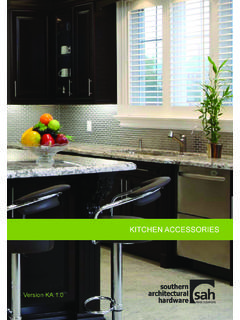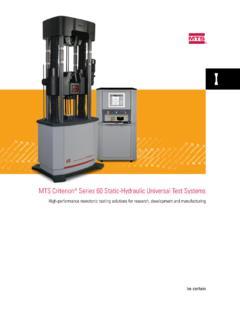Transcription of Getting to grips with slips and trips - Health and …
1 Getting to grips with slips and trips Real workplaces, real problems to be overcome, real solutions and real benefits. Sharing experiences from real life About this publication This publication has been compiled from case studies and real life examples of slip and trip situations in actual workplaces. It illustrates the sorts of situations that have faced employers (and others). Many of the cases set out what they did to tackle the slip and trip issues and how they went about it, others illustrate the consequences of failing to take the right sort of action. HSE s slips & trips Programme Team has extensive experience of providing training and briefing sessions on slips and trips and of working to help, equip and motivate people to deal with slip and trip risks as a real workplace issue. That experience has shown that there is nothing quite like using actual examples of situations that have been faced in real life and the practical solutions (or real consequences) to help people come to terms with what needs to be done and how they can go about it.
2 This publication is intended to do just that. These case studies and examples are real. They are not perfect or model scenarios thought up to get across particular points. They tell of the actual circumstances, how people found solutions that worked for them or suffered the consequences of not doing so. We hope that you would be sufficiently interested to look at each of the case studies - each has a story to tell or a lesson to learn from - but there are also tables of contents to help you access the information that may be of most relevance and interest to you. They are arranged to lead you to the cases that might be of most interest, examples in the industry sectors most closely related to your own and cases where particular risk factors or possible solutions have come into play. To set the scene there is some introductory information on slip and trip risks in the workplace, how they arise, what leads to them and what this means for individuals, businesses and the country as a whole.
3 It explains why such an effort is being put into tackling slips and trips ands starts to explore what can be done. This scene-setting information includes a simple but useful visual model of what factors contribute to the existence of slip and trip risks in the workplace. Knowing what goes into slip and trip problems can help us rule the problems out. 2 Table of contents About this Table of slips and trips in the A simple slip & trip factors Case Pub-restaurant chain s choice of kitchen floor Slippery store entrance in wet weather - supermarket entrance 16 year-old employee flash fries her arm in 360 F oil following Badly installed safety floor in a swimming pool changing Wet mopping can increase the risk of Ramped walkways at a railway Young woman loses her leg after two slip Anti- slip walkways reduce slip risks in large food Company changes cleaning methods following accident Poor floor specification threatened opening of Tomato Sauce Mower removes slip victim s Costly supermarket Supermarket worker awarded 200.
4 000 following Prosecuted over a leaking chiller Pet food company reduces slip accidents after introducing new New floor required a different cleaning regime, but did anyone tell the cleaners?..20 Airport carries out a wide-ranging review of pedestrian slip Mobile work equipment and workplace Changing attitudes, tackling risks and reducing slip & trip injuries a multi-faceted approach in a factory Ice build up in cold store costs time and money in a frozen food Mechanical floor scrubber-dryer in shopping Knowing when and where hazards and risks arise plays an important part in incident An error in pedestrian flow A worker was injured when he slipped onto a woodworking 55,000 for teacher who slipped on a Even the messiest of slip potential environments can be Tackling slips & trips in a further education Carpet company fails to look after its own Temporary staff miss out on anti- slip Poor housekeeping causes trip Tackling slip problems in a manufacturing Raised plinths cause trips at electrical Worn out stairs carpet causes serious fall yet still goes Local council reduces slip & trip Entrance matting still wet when shopping centre opened to the Walkway level changes hard to Designing pedestrian safety into Oily floors in an engineering Logical approach cuts slips & trips by two-thirds at food Management taking responsibility and taking the Tapping into workforce knowledge and Fostering workforce commitment for working together for safe
5 Premises and safe Employing solutions in a hierarchical sequence floor contamination, safe floor surfaces, safe behaviour, improved Slipping on dust contamination in a machining Fast food restaurant owners ponder; Which are the right slip prevention options for us? 45 Japanese 5S system in an aluminium foundry better control, fewer 3 Holed walkway went unrepaired for months before injuring a Health service Fractured skull from a wholly preventable catering slip risks on a supermarket s smooth floors sensible long and short-term Caution! Wet Paint!..51 trip risk warnings ignored!..53 Swimming pool slip accident sparks a change for change for the Useful guidance and other Practical Web 57 4 slips and trips in the workplace Slipping and tripping accidents happen everywhere. They are often seen as funny or as being the victim s own fault, although some recent high-profile litigation seem to suggest that slip and trip injuries are no longer being accepted as the sorts of things that just happen.
6 Managers often see no solution and there has been a tendency for Health and safety specialists to concentrate on other areas of Health and safety where they feel more comfortable. Studies show that the biggest barriers to Getting management and workers to act are:- Not taking the risks seriously. Not understanding the causes of slipping. Thinking that slips and trips are inevitable. Poor application of risk assessment and management controls. Over a third of all major workplace injuries are a result of a slip or trip . Almost all of these involve broken bones. These incidents cost employers hundreds of millions of pounds a year in lost production and other costs. They are the single most common cause of injuries at work and they occur in almost all kinds of workplace. slips and trips are responsible for more major injuries in the manufacturing and service sectors than any other cause.
7 They account for over half of all workplace injuries to members of the public. The Government and the Health and Safety Commission have recognised the importance of slips and trips and have included the topic as one of their priorities for action to improve Health and safety performance. slips and trips are responsible for :- Over a third of all major injuries to workers every year. 20% of over 3 day injuries. More than half of all serious injuries to members of the public in workplaces. Costs to employers of 512 million per year. Costs to the Health services of 133 million per year. Research has suggested that 1 in 3 falls from height deaths & injuries & are initiated by a slip or trip . Most slips occur in wet or contaminated underfoot conditions. Most trips are due to poor housekeeping. The solutions to both are often simple and low cost.
8 In many cases the way to get control of slips and trips involves one of the following simple measures (in no particular order) :- Preventing floor contamination. Managing spillages and cleaning regimes. Effective matting systems. Choice of suitable footwear. Design of the workplace and work activities. Maintenance of plant and the work environment. Specification of appropriate flooring. Housekeeping. Effective training and supervision. This publication is a showcase of things that have happened in real workplaces, real problems that people have faced, real solutions that have been applied, bright ideas that people have used, real results that have been achieved or even the real consequences of Getting things wrong. We can all learn by sharing experiences. 5A simple slip & trip factors model People often make assumptions and jump to conclusions - we all do!
9 Those assumptions can sometimes let us down. Efforts to tackle slips and trips can fall victim to misleading preconceptions and lead to the wrong conclusions and actions. The real factors that cause slips and trip risks in a particular case can easily be missed or underplayed. The illustration above is a simple representation of the main factors that contribute to pedestrian slip and trip risks. For the most part the factors are quite straightforward, not requiring special skills or knowledge to handle. Contamination. Most slips & trips are actually slips and the vast majority of those happen in wet or contaminated underfoot conditions. Keeping walking surfaces free from contaminants is probably the best thing that can be done to prevent slips . Think about what contaminants there might be (Are there spillages, is water walked in on shoes, does cleaning leave floors wet?)
10 Etc.). Preventing contamination and managing floor cleaning reduce slip incidents. Remember that dry contaminants, such as dusts, cause slips just like liquids. The way that floors are cleaned can have a real effect on reducing slip risks. Prompt attention to spillages limits the effect of the contamination. Risks can be reduced by leaving floors clean and dry and safe to walk on after cleaning (not mop wet ). Proper cleaning methods and materials also play a big part in helping the floor to keep its grip . Bad cleaning methods cause problems, good cleaning methods significantly reduce risks. The trips equivalent of floor contamination are obstacles - litter, debris & things on the floor where they shouldn t be. Floor contamination and obstacles are implicated in most slip & trip incidents - so they are good things to think about as early options for action.












![INDEX [hosesolutions.com.au]](/cache/preview/0/e/a/7/e/3/f/9/thumb-0ea7e3f9ea4b923c6b71ff3ae5ad9a01.jpg)

